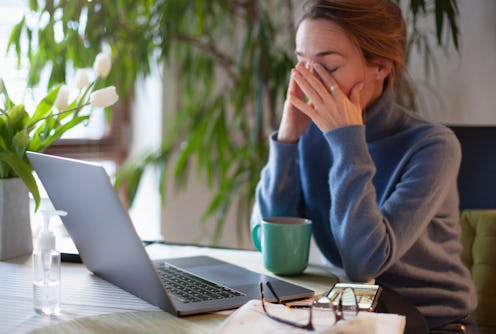Life
Eye Doctors Explain What All This Screen Time Is Doing To Your Baby Blues

The coronavirus pandemic has meant that people are at home more than ever — some working, many not. One survey by research company Gartner found that the amount of people working remotely may increase by up to 30% for the foreseeable future. If you've been dealing with eye problems after marathoning Tiger King or spending hours in a Zoom meeting, experts say, stress and screen time might be responsible.
Before coronavirus, it was estimated that American adults could spend 12 hours a day looking at screens. The pandemic has only increased the amount of screen time most people have per day, without any of the usual breaks. "You are not getting up and walking around the office to talk to a co-worker," Dr. Benjamin Bert M.D., an ophthamologist at MemorialCare Orange Coast Medical Center, tells Bustle. "Even meetings are now virtual and on a screen." Dr. Howard Krauss M.D., neuro-ophthamologist at Providence Saint John's Health Center, says a lot of people might have a syndrome he's calls "ocular confinement syndrome — increased irritation, burning, tearing, redness, eyestrain, fatigue, and headache."
Digital eye strain is largely caused by blinking — or the lack of it. "When we are reading or concentrating, our minds suppress our blink rate, because a blink momentarily interrupts our attention," Dr. Krauss says. The American Academy of Ophthamology noted in 2019 that focusing on computer screens and digital displays can reduce a person's blink rate by a third to a half. (Bet you're thinking about your blinking now.) That can cause your eyes to dry out and feel irritated, especially if you have an A/C that keeps your room's humidity low.
For some people, digital eye strain isn't caused by dry eyes, but by what's called accommodative eye strain, or pain from focusing on things close-up. "Looking at a near target for a long period of time causes the eyes to accommodate, using muscles inside of the eyes to try and focus," Dr. Bert says. If you have double vision or blurred vision when you look up after doing cross-stitch, that's called an accommodative spasm, Dr. Krauss says, and it should resolve by itself.
A study published in BMJ Open Ophthamology in 2018 found that accommodative eye strain tends to make your vision blurry or unfocused, while dry eyes are more likely to make your eyes physically hurt. You might get accommodative eye strain because of undiagnosed vision problems, like farsightedness, astigmatism, or issues with focusing.
Different physical factors can contribute to digital eye strain. A study published in Optometry in Practice in 2016 found that high screen glare, the angle of the screen, and looking at tiny text for prolonged periods can all make eye strain worse. The ideal angle for a screen is 20 to 28 inches away from the eye and slightly downward — not three inches from your nose, even if that seems like the best way to watch Love Island.
For what it's worth, blue light from electronic devices isn't seen as a major source of eye problems. The American Academy of Opthamology said in 2020 that while exposure to blue light may slightly heighten risk of eye issues in some, it's not a problem for the majority of people. Digital eye strain from lack of blinking will cause a lot more discomfort.
If you're not spending a lot of time on a screen right now but still feel your eyes hurting, stress may be to blame. A study published in EPMA Journal in 2018 found that higher levels of stress hormones can negatively affect vision and eye diseases. It's also common for people with high anxiety levels to experience blurred vision, light sensitivity, or tunnel vision in a panic attack. Stress dilates our pupils and narrows our field of vision, so if your vision changes while you're thinking about the current state of the world, it's likely the body's natural reaction to stress hormones.
Try to switch things up during the day if you notice your eyes hurting. Ophthamologists advise the 20-20-20 rule: every 20 minutes, switch your eyes from the screen to something at least 20 feet away for at least 20 seconds. "During these little breaks, close the eyes completely for one to two seconds," Dr. Bert says. "If, while the eyes are closed, they start to burn or feel irritated, then they are already starting to become dry." Eye drops, screen filters that reduce glare, and trying to blink as much as possible can also help. And if your eyes are still bone dry or you can't focus on what's in front of you, consider taking a break from screens altogether if you can.
Studies cited:
Coles-Brennan, C., Sulley, A., Young, G. (2019) Management of digital eye strain. Clin Exp Optom. 102(1):18-29. doi: 10.1111/cxo.12798.
Rosenfeld, M. Computer vision syndrome (a.k.a. digital eye strain). (2016) Optometry in Practice. 17 (1): 1-10.
Sabel, B.A., Wang, J., Cárdenas-Morales, L. et al. (2018) Mental stress as consequence and cause of vision loss: the dawn of psychosomatic ophthalmology for preventive and personalized medicine. EPMA Journal. 9, 133–160.. https://doi.org/10.1007/s13167-018-0136-8
Sheppard, A.L., Wolffsohn, J.S. (2018) Digital eye strain: prevalence, measurement and amelioration. BMJ Open Ophthalmology. 3:e000146. doi: 10.1136/bmjophth-2018-000146
Experts:
Dr. Benjamin Bert M.D., ophthamologist
Dr. Howard Krauss M.D., surgical neuro-ophthamologist